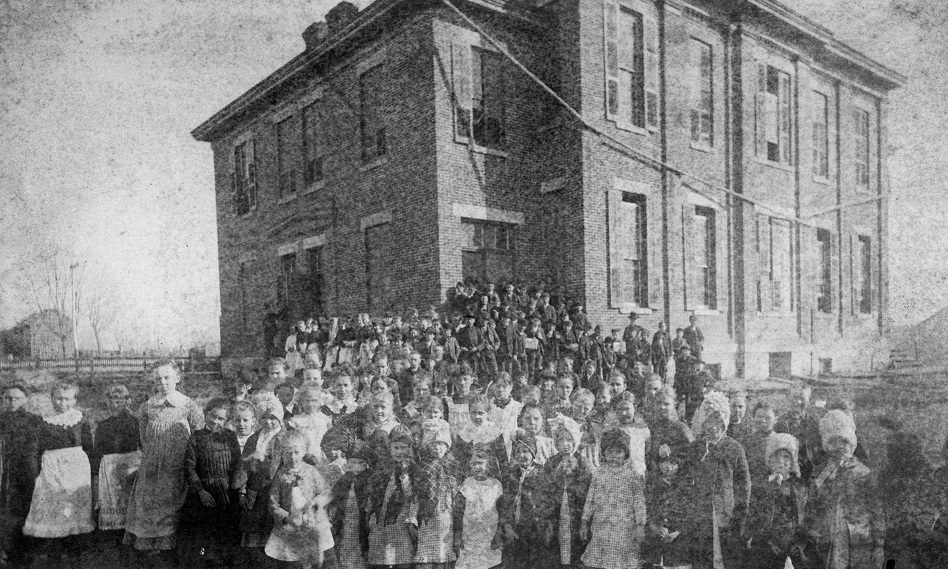
Most Americans associate the history of school segregation with Southern and urban communities, a physical distance that may create a sense of separation for some Nebraskans. Nevertheless, for a time during the later nineteenth century, at least two Nebraska towns maintained segregated schools. The story of how these schools were created and the ways that African Americans confronted the color line in Nebraska does more than simply expand the geographic borders of historiography, it challenges some established ideas by showing that demographic and financial matters were central to the decision to operate separate schools.
The Civil War and early years of Reconstruction led to renewed interest in the issue of black education throughout the nation. In 1867, members of Omaha’s black community waged a campaign for equal access to public schools. These efforts may have influenced the nearly simultaneous and unanimous resolution of the state’s teachers association in favor of black education. Although the resolution was unanimous, it was also ambiguous, as it made no mention of the crucial issue of whether Nebraska’s white and black children should be educated in the same classroom. As a result, the resolution carried little significance as most Northerners already agreed that some provision must be made for the education of black children.
Most lawmakers in the region were concerned about how expensive of mandating separate schools would be. While they typically viewed racial segregation as the most desirable solution to the question of black education, they understood that any requirement of separate schools could be too expensive given the demographics of the territory. As a result, during its final session in 1867, the territorial legislature passed a bill that removed the word “white” from the school laws while also gett a clause that would have mandated that separate schools be maintained.
The bill’s sponsor, Augustus Harvey, responded to the removal of his bill’s segregation clause by voting against the bill in committee and offering the following minority report demanding that the bill be passed in its original form:
The bill as referred to the committee provides for the education of colored youth. It gives them all the privileges and advantages of the common school system, the means of a free education, and lays the foundation of their usefulness to the extent of their ability as humble members of the body politic. To the proposition of the original bill, authorizing the Boards of education to provide separate schools for colored children, the undersigned agree, and will heartily concur in any action of the House which may adopt it.
Despite Harvey’s continued objections, the House approved the committee’s majority report and removed the segregation clause by a vote of nineteen to thirteen. Following a lengthy and unrecorded debate, Harvey removed his opposition and voted with the twenty-five to ten majority in favor of the bill. Members of the legislature’s council mirrored their house colleagues in voting down provisions to amend the bill and require segregation. However, they nearly passed an amendment to rename the bill from “An Act to remove the Distinctions on Account of Race and Color in the School Laws of Nebraska” to “An Act to Amend Sections 18 and 48, of Chapter 48, Part 1, of the Revised Statutes.” The angry tone of editorials against a law some Nebraskans feared would lead to social equality likely influenced the council’s attempt at camouflage, yet Harvey’s amended bill passed the council by a ten to three vote.
Although possible, it is not likely that any of Nebraska’s other cities ever maintained separate public schools. It is also unlikely that any Nebraska school beyond Nebraska City and Omaha employed a black teacher during the nineteenth century. Members of Lincoln’s black community presented a petition to the school board in 1886 requesting that they hire African American teachers. Although the matter was referred to the committee on personnel, board records indicate that the matter was never discussed publicly and no black teachers were hired in Lincoln for nearly six decades. Community activism in Omaha led to the hiring of a black teacher during the 1890s, and several more in the following decades. Perhaps most interesting and relevant to modern discussions about race in the Omaha schools is the appearance that Omaha’s neighborhoods and schools were more racially integrated in the late nineteenth century than the present day.
This is an excerpt from “A Double Mixture: Equality and Economy in the Integration of Nebraska Schools, 1858-1883” by David Peavler Trowbridge, which appeared in the winter 2011 issue of Nebraska History.



